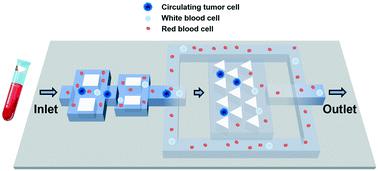Our official English website, www.x-mol.net, welcomes your
feedback! (Note: you will need to create a separate account there.)
A novel microfluidic device integrating focus-separation speed reduction design and trap arrays for high-throughput capture of circulating tumor cells
Lab on a Chip ( IF 6.1 ) Pub Date : 2020-10-14 , DOI: 10.1039/d0lc00631a Chunyang Lu 1 , Jian Xu 2 , Jintao Han 1 , Xiao Li 3 , Ningtao Xue 4 , Jinsong Li 4 , Wenhua Wu 4 , Xinlei Sun 5 , Yugang Wang 1 , Qi Ouyang 6 , Gen Yang 1 , Chunxiong Luo 7
Lab on a Chip ( IF 6.1 ) Pub Date : 2020-10-14 , DOI: 10.1039/d0lc00631a Chunyang Lu 1 , Jian Xu 2 , Jintao Han 1 , Xiao Li 3 , Ningtao Xue 4 , Jinsong Li 4 , Wenhua Wu 4 , Xinlei Sun 5 , Yugang Wang 1 , Qi Ouyang 6 , Gen Yang 1 , Chunxiong Luo 7
Affiliation

|
Isolation and analysis of circulating tumor cells (CTCs) from peripheral blood provides a potential way to detect and characterize cancer. Existing technologies to separate or capture CTCs from whole blood still have issues with sample throughput, separation efficiency or stable efficiency at different flow rates. Here, we proposed a new concept to capture rare CTCs from blood by integrating a triangular prism array-based capture apparatus with streamline-based focus-separation speed reduction design. The focus-separation design could focus and maintain CTCs, while removing a considerable proportion of liquid (98.9%) containing other blood cells to the outlet, therefore, a high CTC capture efficiency could be achieved in the trap arrays with a high initial flow rate. It is worth mentioning that the new design works well over a wide range of flow rates, so it does not require the stability of the flow rate. The results showed that this novel integrated chip can achieve a sample throughput from 5 to 40 mL h−1 with a stable and high CTC capture efficiency (up to 94.8%) and high purity (up to 4 log white blood cells/WBC depletion). The clinical experiment showed that CTCs including CTC clusters were detected in 11/11 (100.0%) patients (mean = 31 CTCs mL−1, median = 25 CTCs mL−1). In summary, our chip enriches and captures CTCs based on physical properties, and it is simple, cheap, fast, and efficient and has low requirements on flow rate, which is very suitable for large-scale application of CTC testing in clinics.
中文翻译:

集成了焦点分离减速设计和捕获器阵列的新型微流控设备,可高通量捕获循环肿瘤细胞
从外周血中分离和分析循环肿瘤细胞(CTC)提供了检测和表征癌症的潜在方法。现有的从全血中分离或捕获四氯化碳的技术仍然存在样品通量,分离效率或在不同流速下稳定效率的问题。在这里,我们提出了一个新的概念,通过将基于三棱柱阵列的捕获设备与基于流线的聚焦分离速度降低设计相集成来捕获血液中的稀有CTC。聚焦分离设计可以聚焦并保持四氯化碳,同时将相当一部分含有其他血细胞的液体(98.9%)清除到出口,因此,在具有高初始流速的捕集阱阵列中可以实现高四氯化碳捕获效率。值得一提的是,新设计在很大的流速范围内都能很好地工作,因此不需要流速的稳定性。结果表明,这种新型集成芯片可实现5至40 mL h的样品通量-1具有稳定且高的CTC捕获效率(高达94.8%)和高纯度(高达4 log log白细胞/白细胞耗竭)。临床实验表明,在11/11(100.0%)患者中检测到包括CTC簇的CTC(平均值= 31 CTCs mL -1,中位数= 25 CTCs mL -1)。综上所述,我们的芯片根据物理特性丰富并捕获了四氯化碳,它简单,廉价,快速,高效,对流量要求低,非常适合临床中大量使用四氯化碳测试。
更新日期:2020-11-03
中文翻译:

集成了焦点分离减速设计和捕获器阵列的新型微流控设备,可高通量捕获循环肿瘤细胞
从外周血中分离和分析循环肿瘤细胞(CTC)提供了检测和表征癌症的潜在方法。现有的从全血中分离或捕获四氯化碳的技术仍然存在样品通量,分离效率或在不同流速下稳定效率的问题。在这里,我们提出了一个新的概念,通过将基于三棱柱阵列的捕获设备与基于流线的聚焦分离速度降低设计相集成来捕获血液中的稀有CTC。聚焦分离设计可以聚焦并保持四氯化碳,同时将相当一部分含有其他血细胞的液体(98.9%)清除到出口,因此,在具有高初始流速的捕集阱阵列中可以实现高四氯化碳捕获效率。值得一提的是,新设计在很大的流速范围内都能很好地工作,因此不需要流速的稳定性。结果表明,这种新型集成芯片可实现5至40 mL h的样品通量-1具有稳定且高的CTC捕获效率(高达94.8%)和高纯度(高达4 log log白细胞/白细胞耗竭)。临床实验表明,在11/11(100.0%)患者中检测到包括CTC簇的CTC(平均值= 31 CTCs mL -1,中位数= 25 CTCs mL -1)。综上所述,我们的芯片根据物理特性丰富并捕获了四氯化碳,它简单,廉价,快速,高效,对流量要求低,非常适合临床中大量使用四氯化碳测试。











































 京公网安备 11010802027423号
京公网安备 11010802027423号